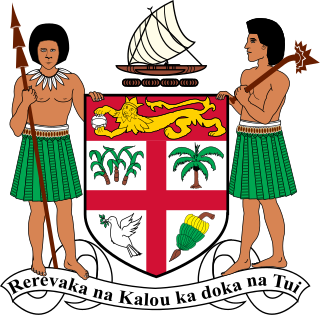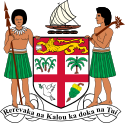
The Alliance Party, was the ruling political party in Fiji from 1966 to 1987. Founded in the early 1960s, its leader was Kamisese Mara, the founding father of the modern Fijian nation. Widely seen as the political vehicle of the traditional Fijian chiefs, the Alliance Party also commanded considerable support among the Europeans and other ethnic minorities, who, although comprising only 3–4% of Fiji's population, were over represented in the parliament. Indo-Fijians were less supportive, but the Fijian-European block vote kept the Alliance Party in power for more than twenty years.

The House of Representatives was the lower chamber of Fiji's Parliament from 1970 to 2006. It was the more powerful of the two chambers; it alone had the power to initiate legislation. The House of Representatives also had much greater jurisdiction over financial bills; the Senate could not amend them, although it might veto them. Except in the case of amendments to the Constitution, over which a veto of the Senate was absolute, the House of Representatives might override a Senatorial veto by passing the same bill a second time, in the parliamentary session immediately following the one in which it was rejected by the Senate, after a minimum period of six months.

Since becoming independent of the United Kingdom in 1970, Fiji has had four constitutions, and the voting system has changed accordingly.

General elections were held in Fiji between 19 March and 2 April 1977. As a result of a split in the ethnic Fijian vote, the ruling Alliance Party of Prime Minister Kamisese Mara suffered a narrow defeat. Although the Alliance Party received the most votes, it won only 24 seats, two fewer than the Indo-Fijian-dominated National Federation Party (NFP). One seat was won by the Fijian Nationalist Party, with the remaining seat going to an independent candidate, Osea Gavidi.

Early general elections were held in Fiji between 17 and 24 September 1977. They followed elections in March which resulted in a hung parliament and no party able to gain a majority. The new election resulted in a landslide win for the Alliance Party (Fiji) led by Prime Minister Kamisese Mara, which won 36 seats out of 52. It was aided by a split in the main opposition, the National Federation Party (NFP) and a decline in support for the Fijian Nationalist Party.

General elections were held in Fiji between 10 and 17 July 1982. The paradoxical results were both a triumph and a setback for the Alliance Party of the Prime Minister, Kamisese Mara. The Alliance received 52% of the popular vote, only slightly down on its previous total, but won only 28 seats, eight fewer than in the previous elections of September 1977. Part of the reason for this discrepancy was that the slight surge in support for Mara's Alliance in the Indo-Fijian community, from 14 percent to 16 percent, was not sufficient to translate into seats in Fiji's communal electoral system, and did not therefore off-set losses among the ethnic Fijian community, particularly in the west of the country. The Western United Front of Osea Gavidi won only two seats, but split the vote, allowing the National Federation Party (NFP), with which it tactically allied itself, to gain seven seats for a total of 22. The NFP, which had split into two factions before the previous elections, had been reunited.

General elections were held in Fiji between 4 and 11 April 1987. They marked the first electoral transition of power in Fijian history. Despite receiving just under 50% of the vote, the Alliance Party of longtime Prime Minister, Kamisese Mara was defeated by a coalition of the Fiji Labour Party and National Federation Party, which won 28 seats to the Alliance's 24. The Labour Party's Timoci Bavadra became Prime Minister.

General elections were held in Fiji between 23 and 30 May 1992. It was the first election held since two military coups in 1987 had severed Fiji's 113-year-old constitutional links with the British Monarchy, and later Fijian Monarchy, and ushered in a republic.

General elections were held in Fiji between 8 and 15 May 1999. They were the first election held under the revised Constitution of 1997, which instituted a new electoral system and resulted in Mahendra Chaudhry taking office as Fiji's first Indo-Fijian Prime Minister, following a landslide victory for the Fiji Labour Party. It was also a wipeout loss for the incumbent Soqosoqo ni Vakavulewa ni Taukei (SVT) government of Sitiveni Rabuka, which lost all but eight seats and won less seats than the Fijian Association Party (FAP).

The National Federation Party is a Fijian political party founded by A.D. Patel in November 1968, as a merger of the Federation Party and the National Democratic Party. Though it claims to represent all Fiji Islanders, it is supported, in practice, almost exclusively by Indo-Fijians whose ancestors had come to Fiji between 1879 and 1916, mostly as indentured labourers. However, in the 2018 general election, the party recorded a considerable change in its support base due to the inclusion of more indigenous Fijian candidates.
"General Electors" is the term formerly used in Fiji to identify citizens of voting age who belonged, in most cases, to ethnic minorities. The 1997 Constitution defined General Electors as all Fiji citizens who were not registered as being of Fijian, Indian, or Rotuman descent. Also included were citizens who did qualify to be registered in the above categories, but who chose not to be. Persons of biracial or multiracial ancestry could opt to enroll either as General Electors, or as descendants of any of the other three groups to which they had an ancestral claim. General Electors were thus a diverse electorate, whose members included Europeans, Chinese, Banaban Islanders, and many smaller groups. They were allocated 3 seats in the House of Representatives, the lower and more influential house of the Fijian Parliament.
Sir Vijay Raghubar Singh, KBE was an Indo-Fijian lawyer and politician who held Cabinet office in the 1960s and 1970s. Vijay Singh served in Prime Minister Ratu Sir Kamisese Mara's government in a variety of positions, including Attorney-General, and was president of the Indian Alliance, a division of the ruling Alliance Party. He quit the party in 1979 following disagreement with Alliance leadership and later joined the opposition National Federation Party. Vijay Singh was involved in the restructure of the Fiji sugar industry and was a leading member of the Jaycees movement in Fiji.

General elections were held in Fiji between 26 September and 8 October 1966, the last before independence in 1970 and the first held under universal suffrage. The result was a victory for the Alliance Party, which won 23 of the 34 elected seats. Its leader Kamisese Mara became the country's first Chief Minister the following year.

Communal constituencies were the most durable feature of the Fijian electoral system. In communal constituencies, electors enrolled as ethnic Fijians, Indo-Fijians, Rotuman Islanders, or General electors vote for a candidate of their own respective ethnic groups, in constituencies that have been reserved by ethnicity. Other methods of choosing parliamentarians came and went, but this feature was a constant until their final abolition in the 2013 Constitution.

National constituencies were a former feature of the Fijian electoral system. They were created as a compromise between demands for universal suffrage on a common voters' roll, and for a strictly communal franchise, with Parliamentary constituencies allocated on an ethnic basis and elected only by voters enrolled as members of specific ethnic groups.

General elections were held in Fiji between 6 and 13 May 2006.
James Shankar Singh, MBE was a Fiji Indian farmer, businessman, social worker and politician who served as a Minister in the Alliance Government of Ratu Sir Kamisese Mara. Like many Fiji Indian politicians of the era, he joined the Alliance Party with a belief in mutiracialism, but was disappointed with the Alliance Party's appeal to Fijian nationalism after 1977 and left the Alliance to join the National Federation Party.
The Federation Party was Fiji's first formal political party. The Citizens Federation, which had won three of the four seats reserved for Indo-Fijians at the 1963 elections, decided to formalize its role as a political party, which was officially founded on 21 June 1964 with A. D. Patel as President and Sidiq Koya as Vice-President. The merger took place in time for the party to participate in the 1965 constitutional conference which was called to map out a path towards independence from the United Kingdom. In 1968, the Federation Party merged with the National Democratic Party to form the National Federation Party, which is now (2021) the oldest political party in Fiji still in existence.
Mohammed Taiyab Khan was an Indo-Fijian politician and lawyer. Between 1966 and 1977 he served as a member of the Legislative Council, Senate and House of Representatives. He was also Minister for Commerce, Industries and Co-operatives from 1972 to 1976.



